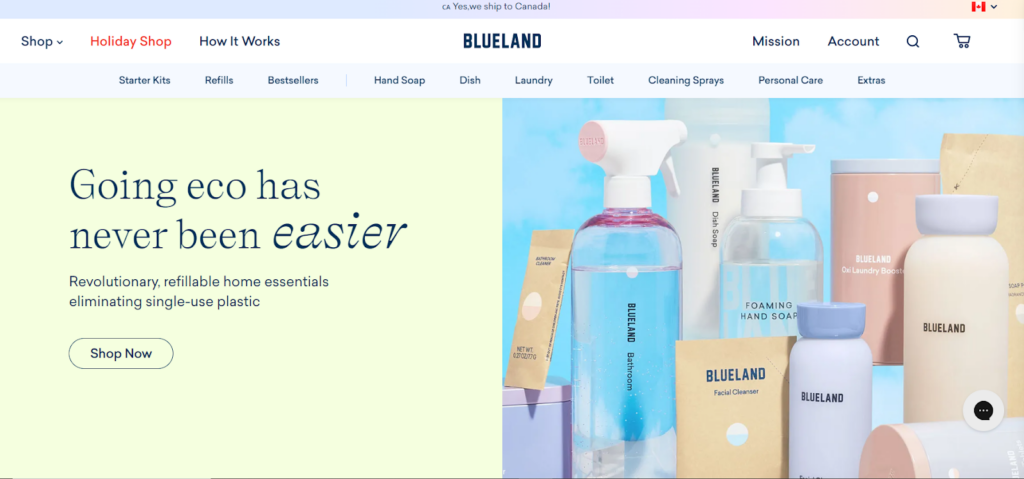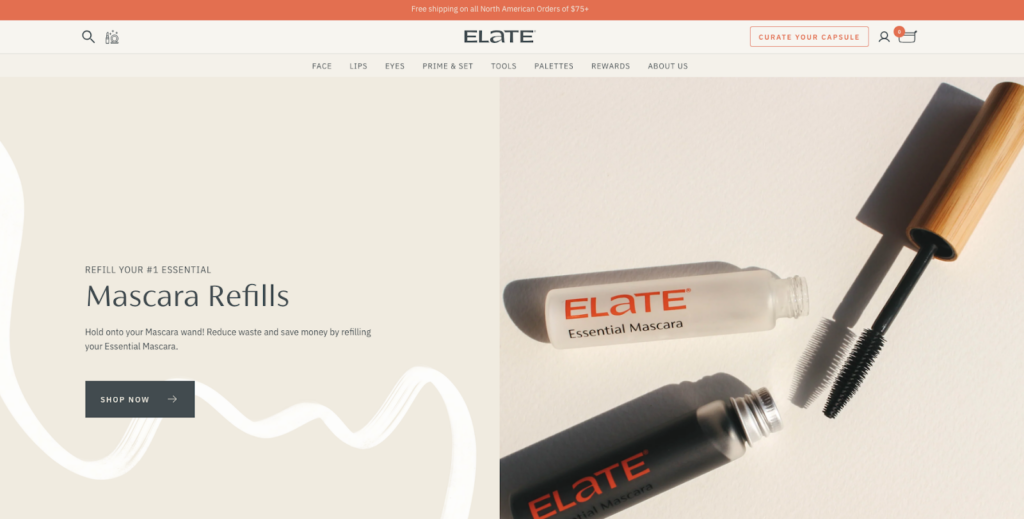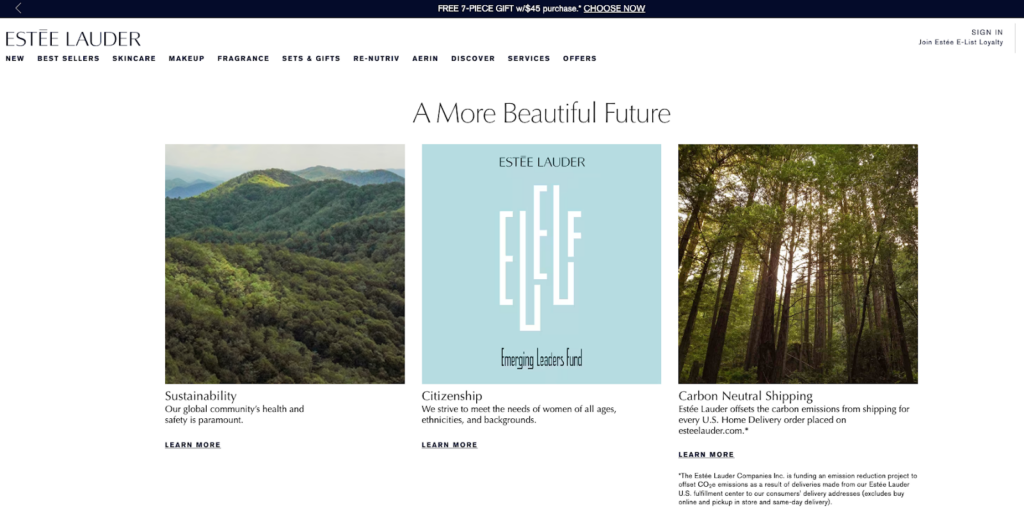What is sustainable ecommerce? The definition is fluid and can start with informing and gently nudging customers towards more ecologically and socially conscious purchasing choices. A pop-up at checkout could display the emissions involved with purchasing a certain product.
Some ecommerce companies aim to sell products with minimal or reduced environmental impacts or ones made of sustainable materials. Products can also be ethically sourced or companies can implement manufacturing processes oriented towards supporting supply chain workers’ wellbeing.
Leaders in this space aim to transform their entire business practice to ensure waste and carbon emissions are limited or even eliminated.
A Brief History Of Sustainable Ecommerce
Sustainable ecommerce presents a basic business case: consumer demand exists alongside a need in the market. According to a 2020 study, many consumers are looking to change their habits to become more sustainable but only three out of ten have been able to. After the COVID-19 pandemic, consumers said they wanted to reduce their rates of consumption.
Currently, more than half of the global plastic waste is produced by just 20 firms. Ecommerce leader Amazon has created a landing page for sustainable items but has been called out for questionable product inclusions and accused of greenwashing.
On the other hand, there are some bigger companies taking charge with impactful sustainable initiatives. Patagonia, for example, has been an outspoken advocate for more ethical and sustainable business practices. By creating high-quality and long-lasting products, they are able to offer resale products that have been refurbished or repaired. This allows outdoor enthusiasts to reuse products that might otherwise end up in the trash.
Selection Criteria For Sustainable Ecommerce
In full disclosure, while writing this article, my personal feelings of urgency and eco-anxiety are strongly emerging. Summer 2023 saw the worst wildfires ever recorded in my home country of Canada and globally temperatures have soared into “uncharted territory.”
This context has influenced the selection criteria for this article. I chose companies that not only lead customers towards greener consumption and sustainable products, but also introduced new solutions for the eco wellbeing of the planet.
Some are manufacturing items within a circular economy model, cutting waste out of the production equation. Beyond eco-friendly products, there are sustainable initiatives like fair trade production, recycled materials, eco-friendly packaging, transparent supply chains, and carbon footprint reductions.
Most of the companies listed are smaller upstarts, providing fresh eyes on longstanding problems such as plastic pollution, climate change, and excess waste. Certain larger companies may be adding sustainable items to their feature list. Younger disruptors are often more nimble and able to commit to sustainable business models through and through.
Well, let’s dive into the shortlist of sustainable brands. Do keep in mind there are many more examples out there. This is just a sampling of some of the innovators that caught my eye.
General Goods Industry
Problems to solve: We love our stuff. And a lot of it ends up in landfill. A discouraging stat for all the blue bin warriors out there is that only about 9% of plastic gets recycled. According to one study, the average product results in carbon emissions of 6.3 times its own weight during its lifecycle.
E-waste is a huge contributor to landfills with over 5 billion phones estimated to be chucked every year. Accessories ecommerce company Pela says that 1.5 billion phone cases get thrown away annually.
A Good Company

Their solution: They are inventors of their own paper and packaging products made out of stone, as well as electric toothbrush heads built out of bamboo and plant-based phone cases with recycled glass. They work with factories worldwide to design and manufacture products with reduced environmental impact.
A rising tide of innovation lifts others, and A Good Company sells their packaging to other companies at cost in order to encourage less wasteful ecommerce shipping practices. The company also aims for local production, with the stone for paper sourced from construction and manufacturing leftovers.
Their business practice: On their website, A Good Company educates and informs their customers about the impact of paper and other materials. Through a foundation, they donate a portion of their profits to causes such as charity:water and Save the Children.
Pela

Their solution: Inspired by a trip to Hawaii when his young son dug up plastic on the beach, founder Jeremy Lang set out to make accessories out of biodegradable materials. Pela now sells iPhone and iPad cases, smartwatch bands, and other items from a compostable plastic made from a base of flax shive and a plant-based biopolymer. These materials are tested to be free of potentially harmful chemicals like BPA, lead, cadmium, and phthalates. The Canadian company claims their plant-based version of plastic comparatively cuts back on waste production by 80%, while also reducing emissions and water consumption.
Business practice: Pela educates consumers on the difference between biodegradable and compostable plastic, the latter which actually breaks down into carbon dioxide, water, and biomass. They remind buyers that their products aren’t going to break down in a landfill and can’t be recycled. To offset their manufacturing emissions, the company purchases carbon offset credits. Pela also donates to a number of charities and nonprofits, such as the Surfrider Foundation and 1% for the Planet, and will recycle customers’ conventional plastic cases as a trade-in.
Cleaning Industry
Problems to solve: You can quickly run into some pretty nasty problems with cleaning products. With some exceptions (like a 2017 law in California), their formulas and ingredients are not required to be revealed to consumers. This means customers may be purchasing items with fragrances and chemicals linked to hormone disruption or other health concerns. And when you are scrubbing the bath or the toilet, questionable ingredients can even find their way into water.
Blueland

Their solution: Beyond plastic waste, consumers are becoming increasingly aware of the emissions costs of shipping. Adding water as a base to cleaning products is not needed when a tablet and a homemade solution can do the trick. Blueland produces cleaning products, soaps, and detergents in tablets. The company has crafted bottles they intend to sell to customers only once so they can refill them with their own reusable tablets. While Blueland does use synthetic fragrances in some of their products, these have been certified by Cradle to Cradle for their safety for the environment and human health.
Business practice: The company is Certified Climate Neutral, meaning they have to offset emissions from every stage of their manufacturing process with carbon credits and work towards eliminating future emissions. Another kudos to Blueland is that they are honest and clear to customers about their products’ ingredients. They recognize that they aren’t perfect but are making an impact. As part of their carbon-neutral approach, they audit energy and water use at their manufacturing facilities and are certified as a B Corp.
Clothing Industry
Problems to solve: It’s no secret that fashion has a mega waste problem, with textile garbage from North America and Europe piling up on far-off shores. The production of polyester and other synthetic fabrics is causing pollution on ocean floors. And clothing production rates continue to increase, even though only about 12% of textiles get recycled.
MUD Jeans

Their solution: You may have heard of Rent the Runway. How about leasing jeans? That’s the concept behind MUD Jeans. The company also exclusively uses organic or recycled cotton in their products and eliminates the use of harmful chemicals by implementing lasers to create worn effects.
Business practice: MUD Jeans is a certified B Corp and is aiming for a completely circular economy model of denim. The company’s goal is to be the first to make jeans from 100% post-consumer recycled cotton. Using innovative manufacturing, they eliminate ozone emissions and one of their factories operates on rain water alone. They ensure that their materials are ethically sourced from textile producers with fair and safe working conditions who do not use pesticides or any other toxic materials. They also want consumers to stop washing their jeans so darn much.
Cosmetics Industry
Problems to solve: I can’t quite live without cosmetics, but the empty tubes, dropper bottles, and jars leave me with an environmental dilemma. Lack of regulation of chemicals in cosmetics is also concerning, with the onus on companies in the United States to ensure safe ingredients. Related to chemical safety, animal testing of cosmetics may impact the environment and is actually banned in Europe.
Many makeup companies market products as “clean,” although the science on human health impacts remains debated. At scale, harmful ingredients can cause big problems. More than 200 million Americans could be consuming something in their drinking water—forever chemicals, also known as PFAs and often found in cosmetics. Parabens and certain types of sunscreen ingredients have been shown to bleach coral reefs.
Elate

Their solution: To counter the large portion of waste attributed to cosmetics, most Elate Beauty products are refillable and over 75% of their packaging materials are reusable, recyclable, or plantable (yes, you can grow a garden with your garbage). All their makeup is cruelty-free, meaning never tested on animals, and they use vegan and mostly organic ingredients (defaulting to fair trade when necessary).
Business practice: Elate donates to social and environmental causes. They plant one tree for every customer order, resulting in 15K planted so far.
Estée Lauder

Their solution: Founded in the late 1940s, Estée Lauder is very much not young or small like the others on this list. But this cosmetic and skincare giant makes the cut because of their pioneering eco-friendly approach to manufacturing makeup. Since the early 2000s, all manufacturing and distribution sites in the United States, Canada, the United Kingdom, Belgium and Switzerland have gone waste-free. Anything that can’t be recycled or reused is incinerated for energy purposes.
Business practice: Estée Lauder has set ambitious sustainability goals for itself–including an all-electric corporate fleet of vehicles by 2030 and at least 75% sustainable packaging by 2025 (defined as refillable, recyclable, or recoverable). As of 2021, they had reached 59% of that goal. The company also offsets emissions produced by some of its deliveries by contributing to forest management.
It’s on All Of Us To Ensure A Greener Future
The bottom line is we can't buy ourselves into a more sustainable environment. We also have to adjust our habits. Seeing companies take on this responsibility is encouraging, lifting some of the individual burden off consumers.
There are many ways to create a sustainable ecommerce business. I hope you might take inspiration from some of the problem-solving approaches.
Interested in more brilliant ideas? Subscribe to The Ecomm Manager’s Newsletter.


